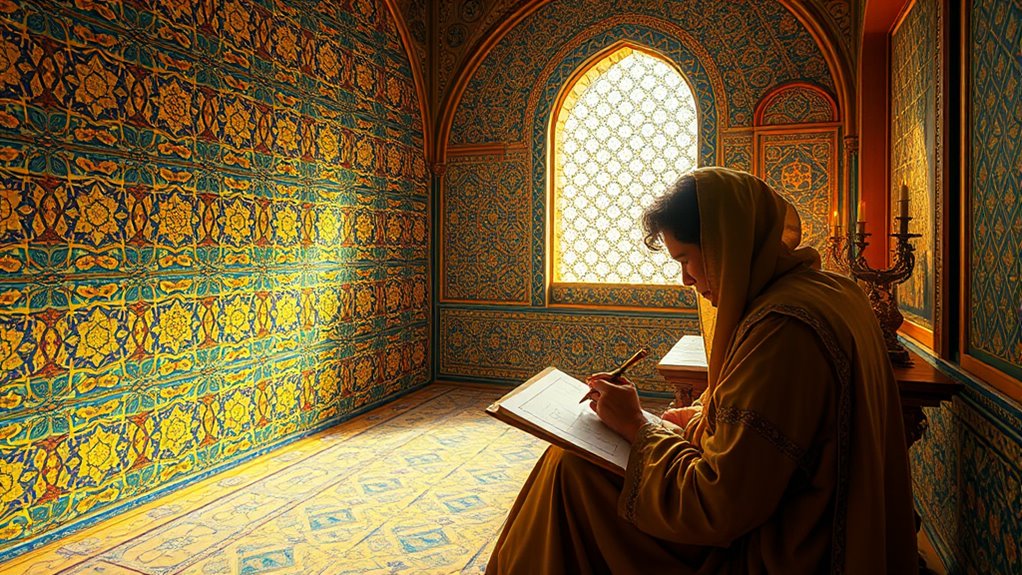During the Islamic Golden Age, scholars like Alhazen and Khayyam made groundbreaking advances in geometry and scientific inquiry. Alhazen revolutionized optics with experiments that laid the groundwork for modern physics, while Khayyam contributed to algebra and geometric solutions, especially cubic equations. Their work combined abstract reasoning with practical applications, shaping future science and mathematics. Keep exploring to discover how their innovations continue to influence modern understanding of geometry and science.
Key Takeaways
- Alhazen (Ibn al-Haytham) advanced optics and the scientific method, emphasizing experimentation and observation in scientific inquiry.
- Omar Khayyam made significant contributions to algebra, geometry, and solving cubic equations during the Islamic Golden Age.
- Islamic scholars expanded geometric knowledge, applying it to architecture, astronomy, and problem-solving techniques.
- Alhazen’s work in optics involved geometric principles, influencing the understanding of light and vision.
- The integration of geometry into scientific methods during this period laid groundwork for modern scientific and mathematical developments.

Have you ever wondered how the Islamic world became a center of innovation and learning during the medieval period? It wasn’t by chance. During the Islamic Golden Age, scholars made groundbreaking advances that shaped the course of history. One of the key reasons was their focus on mathematical innovations, which laid the foundation for numerous scientific contributions. These thinkers didn’t just preserve ancient knowledge; they expanded it, creating new theories and methods that would influence both East and West for centuries.
During the Islamic Golden Age, scholars revolutionized knowledge through innovative mathematics and scientific discoveries that shaped history.
You might be surprised to learn how much the Islamic scholars contributed to mathematics. They developed algebra as a formal discipline, building on Greek and Indian ideas, and introduced techniques that are still used today. Their work on arithmetic, trigonometry, and geometry improved calculations and understanding of the physical world. This period saw figures like Al-Khwarizmi, whose name is where the word “algorithm” originates, revolutionizing problem-solving with systematic methods. These mathematical innovations weren’t isolated; they were essential tools that supported their scientific pursuits.
Speaking of scientific contributions, Islamic scholars made significant advances across various fields. They translated and preserved Greek texts, but also conducted original research. For example, Alhazen—also known as Ibn al-Haytham—pioneered the scientific method, emphasizing experimentation and observation. His work in optics explained how vision works, laying the groundwork for future discoveries in physics and astronomy. You can think of him as a bridge between ancient philosophy and modern science, demonstrating how empirical evidence can lead to understanding.
Meanwhile, Omar Khayyam, famous for his poetic Rubaiyat, was also a mathematician who contributed to the study of algebra and geometry. His work on cubic equations expanded mathematical knowledge, and he engaged deeply with the geometric principles that underpinned their understanding of the universe. These contributions weren’t just theoretical; they had practical applications in architecture, navigation, and astronomy. Their scientific contributions showed how the Islamic scholars combined abstract reasoning with real-world problems, advancing technology and knowledge.
Throughout the Islamic Golden Age, these mathematicians and scientists fostered a culture of curiosity and inquiry. They built on earlier civilizations’ achievements and pushed beyond, creating a legacy that shaped future scientific thought. Their innovations in mathematics and scientific methods helped the world move closer to modern science. In addition, their emphasis on systematic research and experimentation helped establish foundational principles that underpin modern scientific inquiry today. So, when you think of this era, remember it as a time when ideas flourished thanks to a commitment to knowledge, curiosity, and relentless exploration.
Frequently Asked Questions
How Did Alhazen Influence Modern Optics and Vision Science?
Alhazen profoundly influenced modern optics and vision science by conducting optical experiments that challenged earlier ideas. You can see how his work on light reflection and refraction shaped understanding of visual perception. His experiments with camera obscura and the scientific method laid the groundwork for future discoveries. By emphasizing empirical evidence, he transformed optics from philosophical speculation to a rigorous scientific discipline, impacting how we study vision today.
What Role Did Khayyam Play in the Development of Algebra?
Imagine you’re coding in a modern algebraic notation—Khayyam played a vital role in its development, especially in solving polynomial equations. He introduced methods to find solutions to cubic equations, pioneering techniques that laid groundwork for algebra as we know it. His work helped formalize algebraic processes, bridging ancient methods with future innovations, making complex problems more manageable—much like today’s advanced software simplifies calculations.
How Was Geometry Applied in Islamic Architecture During the Golden Age?
You see that geometry plays a key role in Islamic architecture through decorative motifs and structural symmetry. You notice intricate tile work and patterns that reflect complex geometric designs, creating a sense of harmony and beauty. These motifs often follow precise mathematical principles, ensuring the buildings are both aesthetically pleasing and structurally sound. By applying geometry, architects achieve balance and unity, showcasing the cultural and artistic sophistication of the era.
Did Islamic Scholars Translate and Preserve Greek Mathematical Texts?
Imagine walking through a grand library where ancient Greek texts glow softly on the shelves. Yes, Islamic scholars diligently translated and preserved Greek mathematical texts, transforming them into vibrant sources of knowledge. Through meticulous mathematical translation, they kept alive the wisdom of Greek thinkers, allowing their ideas to flourish in new ways. This preservation and translation bridged cultures, inspiring innovations that shaped mathematics and science for centuries.
What Innovations Did Islamic Mathematicians Introduce to Trigonometry?
You discover that Islamic mathematicians introduced significant innovations to trigonometry, like formalizing the sine law, which helps solve triangles more easily. They also expanded tangent functions, making calculations more precise for astronomy and navigation. These advancements allowed for better understanding of angles and distances, shaping future mathematical developments and applications. Their work laid the foundation for modern trigonometry, influencing both science and engineering.
Conclusion
As you explore the Islamic Golden Age, you discover a vibrant tapestry woven with brilliant minds like Alhazen and Khayyam. Their groundbreaking work in geometry is the compass guiding future generations, shaping the course of science and mathematics. Just as a star illuminates the night sky, their contributions continue to shine, inspiring you to appreciate the profound legacy of this golden era—an eternal lighthouse guiding your curiosity through the seas of knowledge.









